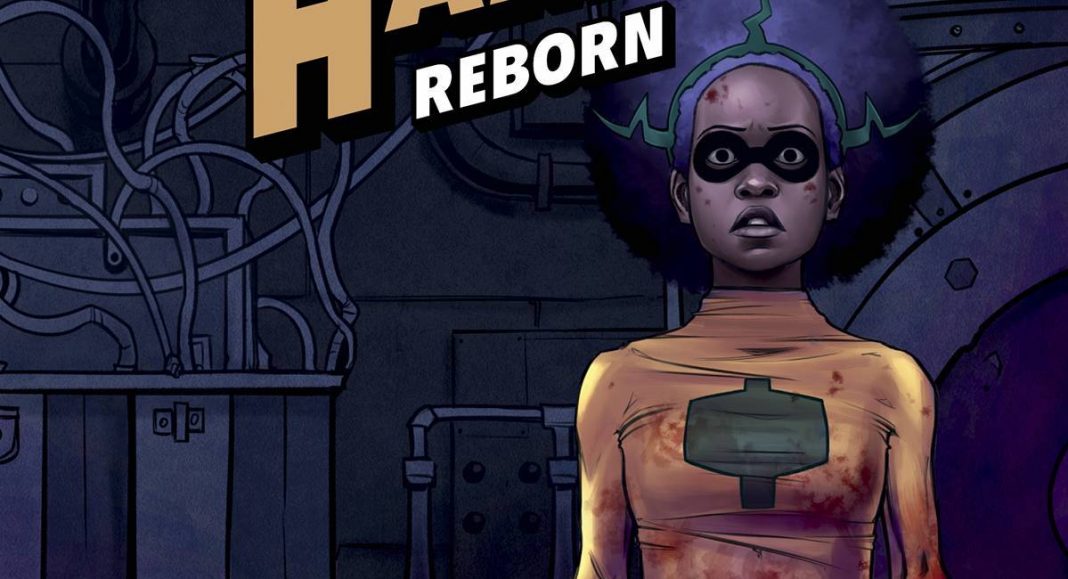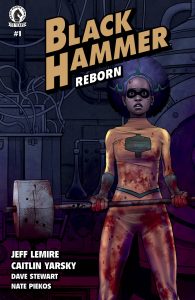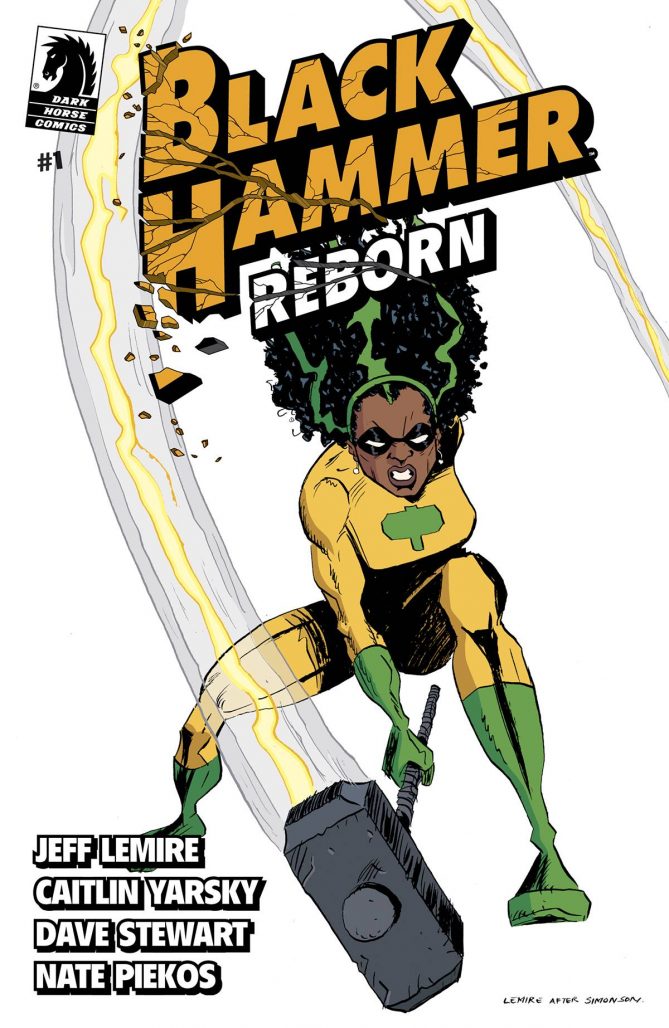Jeff Lemire‘s Black Hammer has been without its main series for over a year now. Since the end of Black Hammer: Age of Doom in 2019, the world of the series has continued to expand in spinoff series like Colonel Weird: Cosmagog, Barbalien: Red Planet, and Skulldigger + Skeleton Boy. This summer, the flagship series returns with the debut of Black Hammer: Reborn, which picks up twenty years after the end of Age of Doom with Lucy Weber, aka Black Hammer, having apparently retired from the role.
Lemire is joined for the new series by artist Caitlin Yarsky, who picks up for the original series artist Dean Ormston, as well as returning colorist Dave Stewart and letterer Nate Piekos. The Beat chatted with Lemire and Yarsky about their work on Black Hammer: Reborn, the series’ big time jump, and expanding the present-day world of Spiral City.
Joe Grunenwald: Jeff, Black Hammer: Reborn picks up twenty years after the events of Age of Doom. What went into your decision to incorporate such a large time jump?
Jeff Lemire: I went back and forth a lot about the direction of this series. I initially started writing it as a story that would pick up right after the events of Black Hammer: Age of Doom and follow Lucy in the immediate aftermath. After writing two or three scripts in this direction it just didn’t feel right. It felt too much like a straight-ahead generic superhero thing and didn’t have enough of those elements that made it feel like “Black Hammer.”
I spent a good year just re-working it and trying to find that element that made it feel the way the farm storyline felt to the original. Then the idea of jumping Lucy ahead and having her with a family of her own really unlocked it. It did two things for me that made the story click: first it allowed me to jump the Black Hammer Universe up closer to our own present time, and then reflect more of our own work into the series, instead of being perpetually stuck back in the ’80s and ’90s, and secondly Lucy’s home life and domestic life gave me something to contrast the more superhero aspects of the story with the way the farm story did in the original Black Hammer run.
Grunenwald: Lucy Weber is in a very different place than she was when last we saw her, and you’ve described this series as her “mid-life crisis on multiple earths.” What interested you in exploring this point in her life? How much of the past twenty years for her will readers get to see?
Lemire: The middle-aged Lucy just opened up all sorts of questions and stories for me and made her a much more complex character to explore. I loved the idea of seeing Lucy at the end of Black Hammer: Age of Doom as the world’s greatest superhero and living up to her father’s legacy and then jumping ahead and finding her in a very different place. She’s no longer Black Hammer. What the hell happened to her?! That’s the story, exploring those intervening years and unlocking the secret of how it all went wrong.
We will see all the key moments that got her to this place, as the series will play with multiple timelines.
Grunenwald: The idea of being trapped, whether it’s in a place or a circumstance, has been something of a throughline for Black Hammer and its spinoffs, and Lucy’s position as Reborn begins feels like a natural progression for that theme.
Lemire: Exactly. It echoes the farm story without just repeating it. It captures that central theme or element of the original Black Hammer but in a new way that is really fun to explore without just retreading those original stories.
Grunenwald: Caitlin, how has your experience been, coming into the established world of Black Hammer? Have there been any particular challenges?
Caitlin Yarsky: Jeff and the Dark Horse team have been exceedingly kind and welcoming to me as a newcomer. And as a reader, I was hooked by the end of the first Black Hammer book. I couldn’t believe how lucky I was to get to add to that universe. I love the characters, their complex relationships and the surreal, malleable reality of the world.
The biggest challenge for me is what it always is — urban landscapes, cars/machines etc. I tend to draw more whimsical, organic environments when given the chance so it puts my perspective/architectural chops to the test when focusing on cities and modern technology. Luckily, there are plenty of really fun, trippy scenes to offset some of the more grounded ones.
Grunenwald: Are there any established characters that you’re looking forward to getting to draw? What about something you’ve never seen in the Black Hammer universe that you hope to add?
Yarsky: This might sound weird, but I LOVE drawing older people. I just think the shapes our faces and bodies make as we age can tell you so much about the lives they’ve led. So for me, Colonel Weird is the character I’m looking forward to drawing the most. His eyes are positively haunted, and makes you feel an automatic empathy for him.
Grunenwald: You’re working with Dave Stewart on this book, and the combination of both of your work on the first issue is absolutely gorgeous. What’s your collaboration with him like? How does it compare for you to when you color your own line art?
Yarsky: Dave Stewart is the first person besides myself to color my inks, which is kind of mind-blowing because he’s a master of his craft. When I first saw the colors I giggled like a little kid, I mean he just brought everything to life. I think the biggest difference is that he uses a wider range of colors and renders a bit more, which gives the characters in particular so much volume and adds depth to the page. I’m SO excited to see how he colors the rest of the issues.
Grunenwald: We’ve seen glimpses of Spiral City in other series, but Reborn is the first longer series to be firmly set in the present day of that location. What’re you both excited to explore about Spiral?
Lemire: I am really excited to finally see more of Spiral, but also to see a Spiral City that reflects our modern world a little more. We don’t just see Spiral in flashbacks anymore, we get to inhabit it and make it more of a real character and place.
It also allows me to bring in characters from all of the various Black Hammer spin-offs and mini-series but see them 25 years later as well. The last few years was about expanding the universe and now I am bringing all those elements back together in this sprawling series and Spiral gives me a great anchor to do that.
Yarsky: When it comes to city scenes, I get most excited about the “extras” — the random people walking the streets. It’s really fun to kind of exaggerate their features, almost in the way animated films do. You get free rein to create these little glimpses of other lives, playing in the background to the main storyline.
Grunenwald: What other media – comics, movies, books, etc. – if anything, has inspired or influenced your work on or approach to Black Hammer: Reborn?
Lemire: I can’t say I had a lot of other stories in my head when working on this If anything this felt like the culmination of all the various Black Hammer stories, so I was really focused on building out the timeline and history of the universe a bit more and seeing that here.
Yarsky: I’ve always been influenced by 2D animated films, from The Iron Giant to The Triplets of Belleville and Spirited Away. I think about animation especially when drawing action sequences — to try to get the gestures down, and keep them from getting too stiff. I also follow a lot of fine artists and traditional illustrators who use their knowledge of anatomy and perspective to break the rules and exaggerate proportions and expressions in unique ways. It helps me push myself and keep trying new things.
Grunenwald: What are you excited for readers to see when they pick up Black Hammer: Reborn #1?
Lemire: I’m excited for them to see Caitlin’s art. Dean Ormston wanted to focus on a more horror driven story, so I have been writing a Madame Dragonfly book for him, and that left the main Black Hammer story without an artist. It was really hard to find the right person to capture everything I wanted to do with Reborn but as soon as I saw Caitlin’s work, I knew she was right. She brings so much humanity to the characters. Lucy’s family feel like real people. I just love the way she is approaching the series.
Aside from that I am also excited for readers to see how characters like Skulldigger, Doc Andromeda, and Sherlock Frankenstein all find their way into this series. Writing Lucy/Black Hammer vs. Skulldigger has been a blast.
Panel detail WIP w/ @BraveTycho pic.twitter.com/ih8DL6SzQ3
— Malachi Ward (@MalachiWard) March 25, 2021
Artists Malachi Ward and Matt Sheean will illustrate issues 5-8 of Black Hammer: Reborn.
Yarsky: Facial expressions and “character acting” is my favorite thing to draw by far, so I hope people connect with the characters and how they’re feeling.
Grunenwald: And finally, Jeff, any update on the development of the Black Hammer TV series?
Lemire: No updates at this time. Legendary’s option on the book has passed. I had a great time adapting it with them, but we are currently looking for a new home. And honesty I am happy to have the space to do new Black Hammer comics and fully commit to that. If and when a TV or film adaptation does happen, that will be exciting, but the comics are my first love and always will be.
Published by Dark Horse Comics, Black Hammer: Reborn #1 arrives in stores on Wednesday, June 23rd, 2021.










